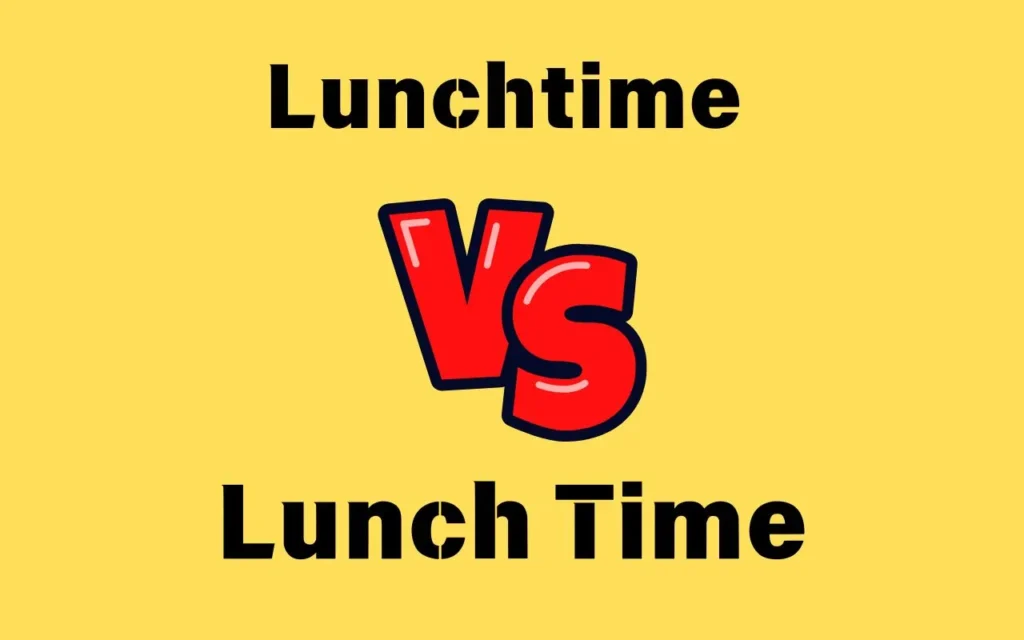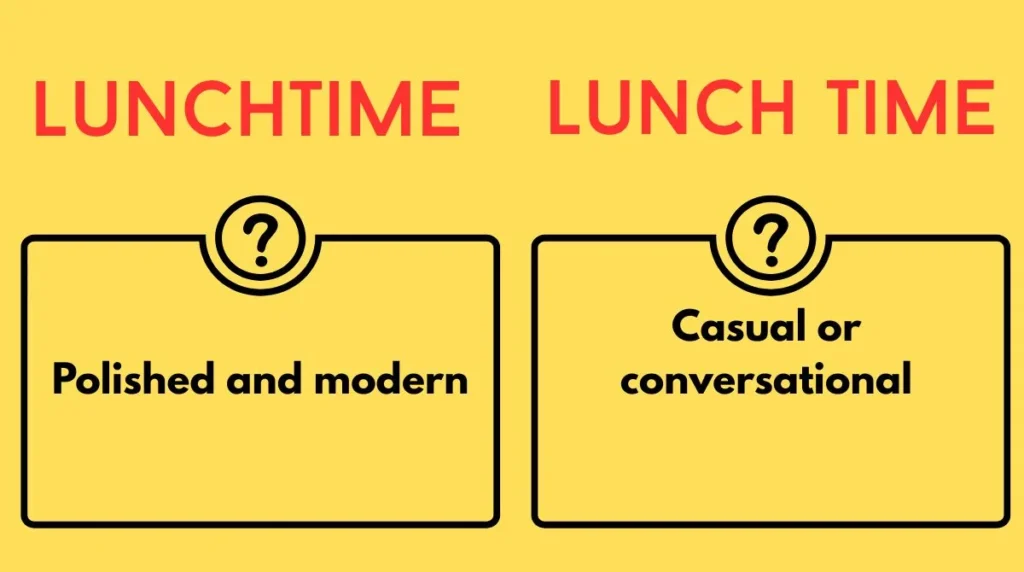Last updated on October 8th, 2025 at 10:09 am
When it comes to expressing the midday meal, should you write it as lunchtime or lunch time?
While these two forms may look similar, their correctness depends on context and grammar rules.
Is it “lunchtime” or “lunch time”? Learn the grammar, usage, and cultural significance of these terms to use them correctly in any context!
This article dives deep into the meaning, grammar, and usage of both terms, exploring their differences, origins, and how they fit into our everyday lives.
Exploring the Definition and Origin of Lunchtime

The word lunchtime is a compound noun formed by joining lunch (the meal eaten in the middle of the day) and time (the period allocated for an activity).
Together, lunchtime refers to the specific time during which lunch is eaten.
Etymology of Lunch:
The term lunch evolved from the word luncheon, which has origins in Middle English lunsh or lumpsh, meaning a small piece or portion. By the 19th century, lunch became a widely accepted term for the midday meal.
Etymology of Lunchtime:
The word lunchtime became popular in English usage around the late 19th century, reflecting the growing need for structured meal breaks during industrial work schedules.
The Grammar of Meal Times: Understanding ‘Lunchtime’
Grammatically, lunchtime functions as a single compound noun, which is why it’s generally written as one word.
On the other hand, lunch time (two words) is technically correct but less commonly used, as it separates the noun lunch and the noun time.
Examples:
- Correct: “It’s almost lunchtime.” (lunchtime as a compound noun)
- Less Common: “We’ll meet at lunch time.” (lunch time separated for emphasis)
Key Grammar Tip: Compound nouns like lunchtime, dinnertime, and breakfast time often simplify over time, consolidating into one word.
The Difference Between ‘Lunchtime’ and ‘Lunch Time’

Although both terms can be used interchangeably, the context matters:
- Lunchtime: A concise and universally recognized term for the time allocated for lunch. It’s considered more formal and polished in written and spoken English.
Example: “Lunchtime is scheduled from 12:30 to 1:30.” - Lunch Time: Emphasizes the separation between the meal (lunch) and the period (time). It might be used in informal or poetic contexts.
Example: “It’s lunch time, and everyone is hungry.”
Quick Comparison Table:
| Feature | Lunchtime | Lunch Time |
|---|---|---|
| Formality | More formal | Less formal |
| Usage Frequency | Commonly used | Less common |
| Tone | Polished and modern | Casual or conversational |
Comparing Other Mealtime Expressions
The evolution of lunchtime mirrors changes in other mealtime expressions.
- Breakfast Time → Breakfast
- Dinner Time → Dinnertime
- Tea Time → Remains as two words in most cases
This consolidation trend reflects the natural progression of language, where frequently used terms simplify for ease of communication.
Historical Usage of the Term Lunchtime
In the late 19th century, the Industrial Revolution played a pivotal role in defining lunchtime. Factory schedules required designated breaks for workers to eat, leading to the formalization of mealtimes.
By the early 20th century, lunchtime became part of the structured workday in Western societies. It was common to hear phrases like, “Workers are entitled to a 30-minute lunchtime break.”
Over time, lunchtime gained prominence as it was more efficient and standardized than saying lunch time.
Lunchtime in Modern Context: Usage Across Various Regions
Lunchtime routines and expectations differ widely across regions:
- United States: Typically observed between 12:00 PM and 1:00 PM in workplaces, schools, and restaurants.
- United Kingdom: Often referred to as “dinner hour” in informal contexts, especially in Northern England.
- Spain: Lunch (or almuerzo) begins later, around 2:00 PM, reflecting the country’s siesta tradition.
While the term lunchtime is widely recognized in English-speaking countries, cultural nuances impact when and how it’s used.
How Lunchtime Varies in the Workplace and Schools
Workplace Lunchtimes
- Corporate Jobs: Employees often have structured lunchtimes, usually lasting 30 minutes to an hour.
- Flexible Jobs: Freelancers or remote workers might define their own lunchtime schedules.
School Lunchtimes
In schools, lunchtime is typically between 11:30 AM and 1:00 PM, depending on the institution. Students are given this time to eat, socialize, and recharge for the rest of the day.
Interesting Fact: Many schools in Japan incorporate kyushoku, a structured lunchtime where students eat together and learn about balanced nutrition.
Cultural Variations of Lunchtime Practices
Mediterranean Countries
- Lunch is the main meal of the day, often lasting 2-3 hours. Lunchtime is viewed as a social event, especially in countries like Italy and Greece.
Northern European Countries
- Lunch is lighter and quicker, often consisting of sandwiches or salads. Lunchtime is short, with an emphasis on efficiency.
Asian Countries
- In China, lunchtime often involves a communal meal, with time allocated for a short nap (similar to a siesta).
Fun Fact:
In France, lunchtime is almost sacred, with laws in place to ensure workers receive adequate breaks to enjoy their meals.
Lunchtime Etiquette: Social Norms and Expectations
Proper lunchtime etiquette varies depending on culture and setting.
- Workplace:
- Avoid smelly or noisy foods in shared spaces.
- Keep lunchtime conversations professional if dining with colleagues.
- Social Gatherings:
- Wait for everyone to be served before starting.
- Follow the host’s cues for when lunch begins and ends.
Common Misconceptions About Lunchtime and Its Correct Usage
- Misconception: “Lunchtime and lunch time are interchangeable in all contexts.”
- Truth: Lunchtime is more appropriate in formal and structured communication.
- Misconception: “Lunchtime must always refer to noon.”
- Truth: Lunchtime varies across cultures, workplaces, and personal schedules.
- Misconception: “Lunchtime is only a modern concept.”
- Truth: While the term lunchtime gained prominence in the 19th century, structured mealtimes have existed for centuries.
FAQs
What is the difference between lunchtime and lunch time?
Lunchtime is a compound noun commonly used to refer to the midday meal period. Lunch time, while grammatically correct, separates the words and is less commonly used.
Is lunchtime one word or two?
Lunchtime is typically written as one word, as it’s a compound noun that simplifies over time, similar to dinnertime or breakfast time.
Why is lunchtime more common than lunch time?
Lunchtime is more concise and formal, making it the preferred choice in modern English. Lunch time may appear in informal or poetic contexts but is less frequent overall.
Does lunchtime refer only to noon?
Not necessarily. While lunchtime is often associated with the midday meal, its exact timing varies across cultures, workplaces, and personal schedules.
How does lunchtime differ across cultures?
Lunchtime customs vary widely: Mediterranean countries enjoy long, social lunches, while Northern Europe opts for shorter, efficient meals. In Asia, communal lunchtimes are common.
Conclusion
Both lunchtime and lunch time are correct, but their usage depends on grammar rules and context. While lunchtime has become the preferred term due to its simplicity and formal tone, lunch time still finds its place in casual or poetic expressions.
Understanding the history, cultural significance, and proper usage of lunchtime not only improves your grammar but also helps you appreciate the diverse practices surrounding this important mealtime.
So, next time you’re scheduling lunch, you’ll know exactly which term to use!
